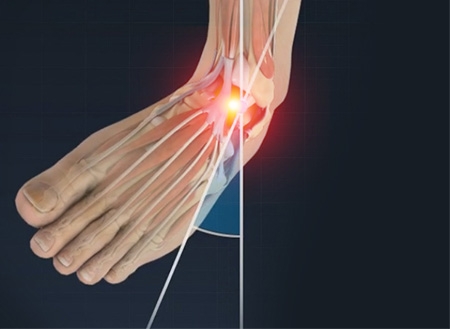When it comes to sports injuries, ankle sprains are one of the most common ailments we see. They can occur, not only during athletic endeavors, but also during common day-to-day activities. No one is immune. We see them in every age group from young children to the elderly. Let's talk about the specifics of this common injury.
'Ankle sprain' is a fairly generic term. When discussing the far more common injury, it is the LATERAL ankle sprain specifically that is being referenced. This is an injury to the soft tissue, specifically the ligaments, that provide stability to the ankle joint. Three ligaments work together to provide that stability. The damage is caused by an inversion mechanism, or the ankle turning inward; thus, stretching the ligaments on the outer aspect of the ankle. The severity of the injury depends on the number of ligaments affected and the degree to which they are stretched. Most commonly, only one of the ligaments is stretched and healing happens relatively quickly with minimal discomfort. Alternatively, if all three ligaments are affected, it is likely that healing will take upwards of 6-8 weeks.
Signs and symptoms of a lateral ankle sprain include pain on the outside aspect of the ankle as well as associated swelling and bruising. Patients find it painful and difficult to walk. Consequently, a limp is usually present. The affected ankle is likely to feel unstable because the supporting tissues have been compromised.
When you come to our office, your doctor will first order x-rays to confirm that the bone is not fractured because lateral ankle sprains and distal fibula fractures present with very similar symptoms. Once fracture is ruled out, the doctor will poke around to find the most painful areas and perform some special tests to determine the degree of laxity present in the joint. For more severe sprains, a pneumatic walking boot will be prescribed and crutches may even be recommended to remove some of the stress from the injured area for the first week or so until the worst of the symptoms subside. In the first couple of weeks, medicines like anti-inflammatories (Ibuprofen, Aleve, Motrin) or a pain reliever (Tylenol) may be helpful in controlling symptoms. Over time, patients will wean from the boot to a simpler ankle brace or compressive ACE bandage, which is what patients with less severe sprains would use from the get-go. If function is slow to improve with simply easing back into activity or if a history of multiple sprains exists, a course of formal physical therapy will likely be recommended. In only very rare cases of continuous re-injury despite physical therapy and use of an ankle brace.
We often hear patients question if a fracture is actually present due to the severity and persistence of symptoms. Soft tissue injuries can be terribly uncomfortable and take far longer to heal than what folks expect. Six to eight weeks for tissue healing is normal, and that is if re-injury or even constant aggravation to the area is avoided. In due time and with proper consideration, these injuries do heal without drastic measures or residual deficits.

